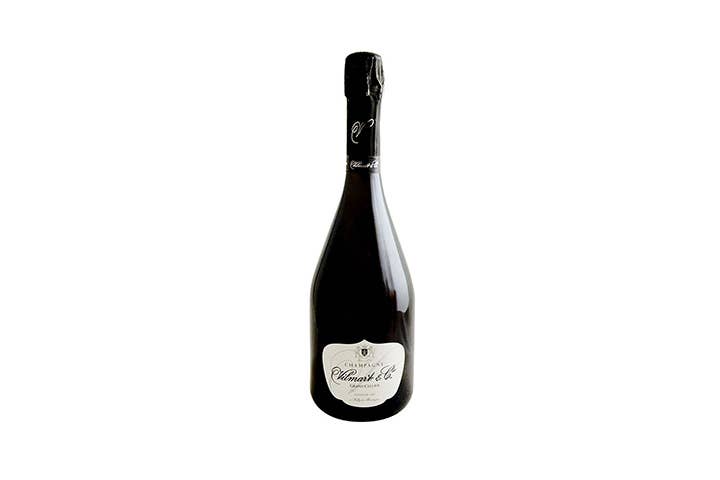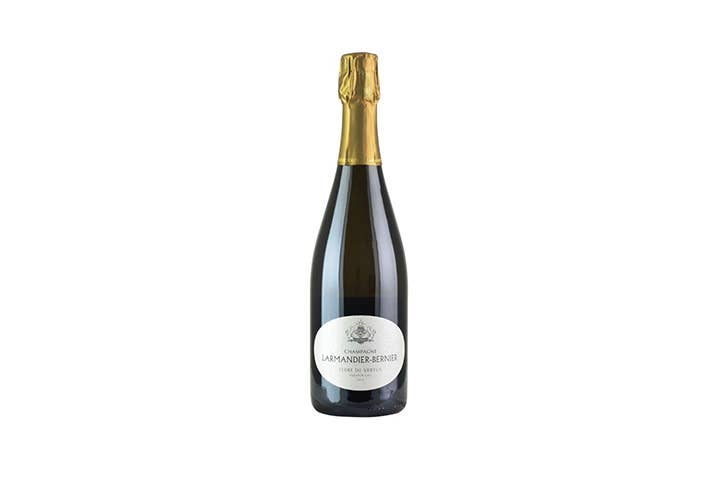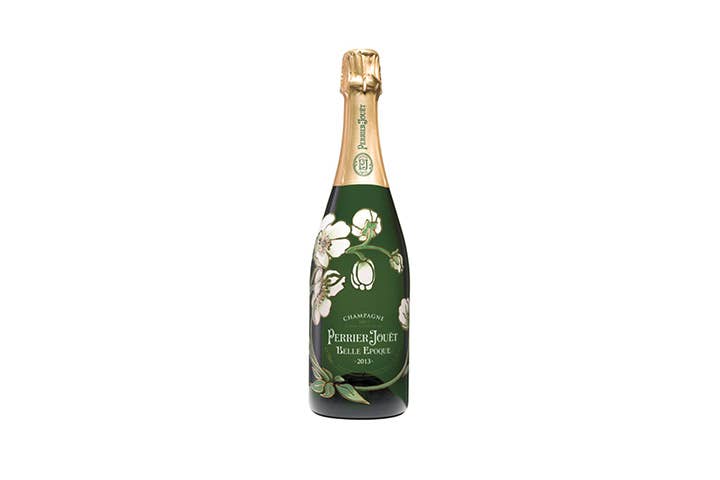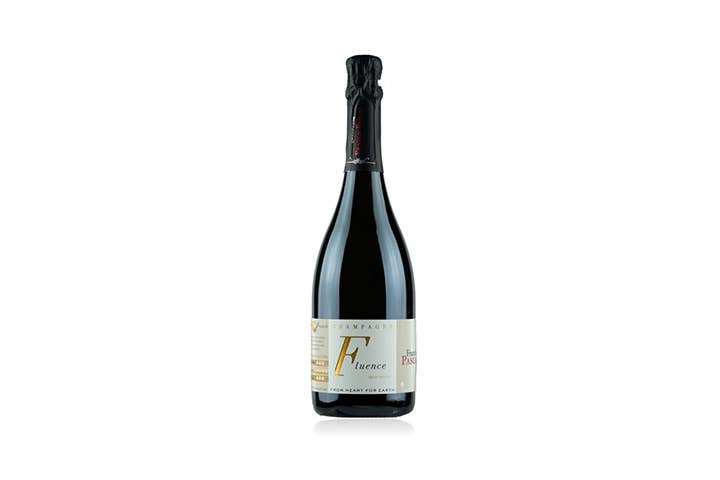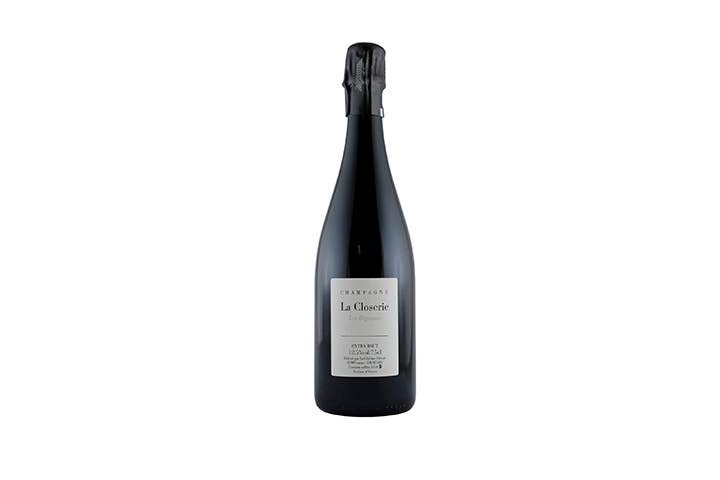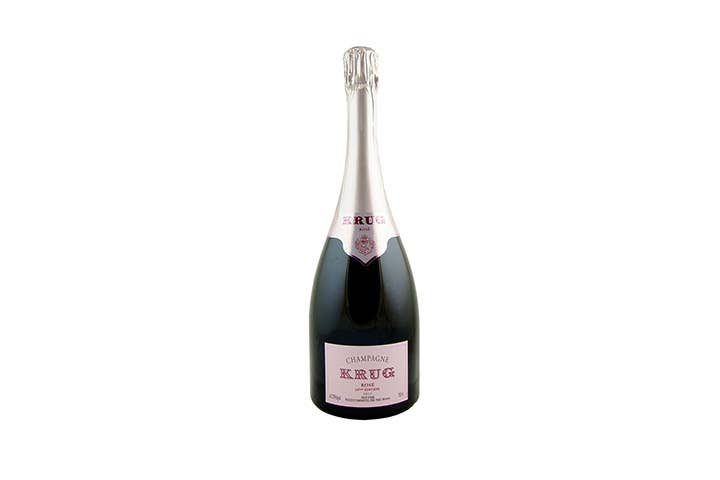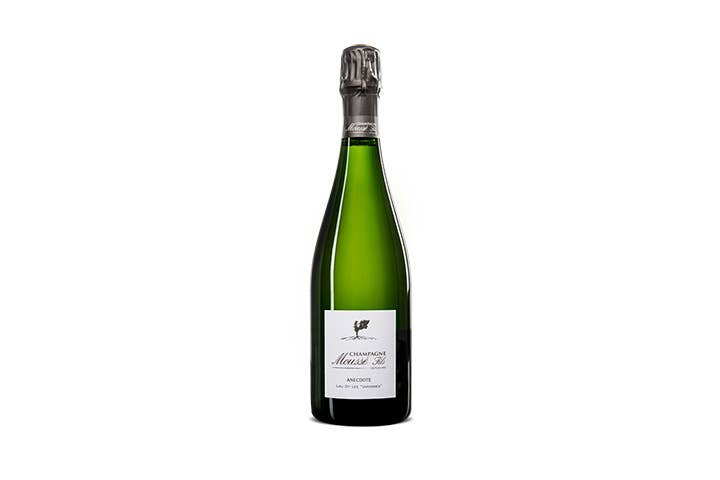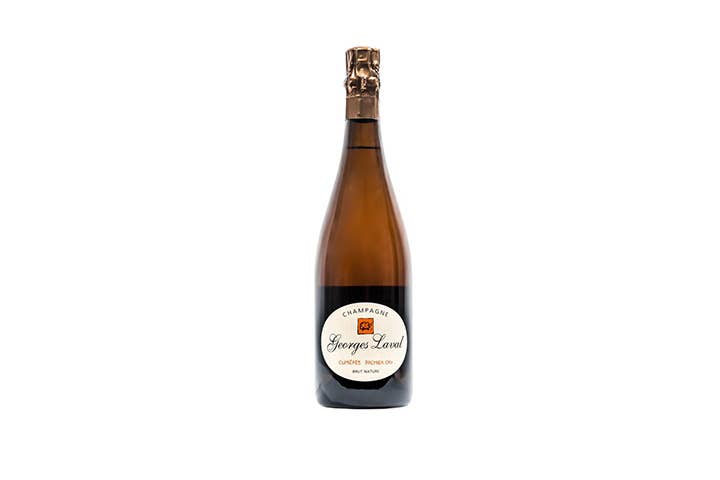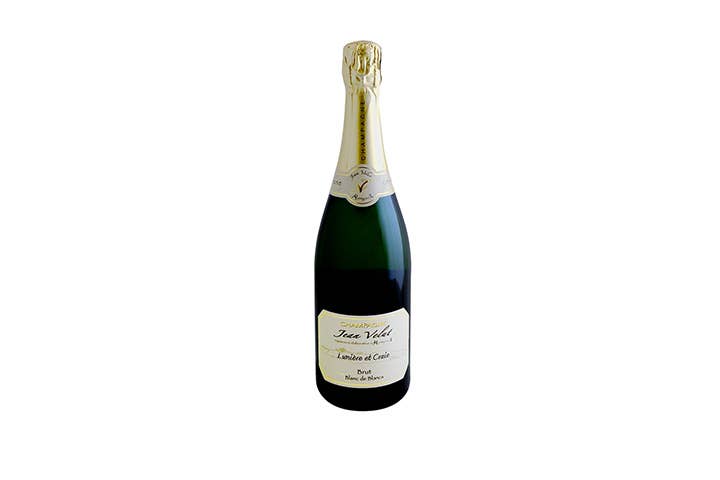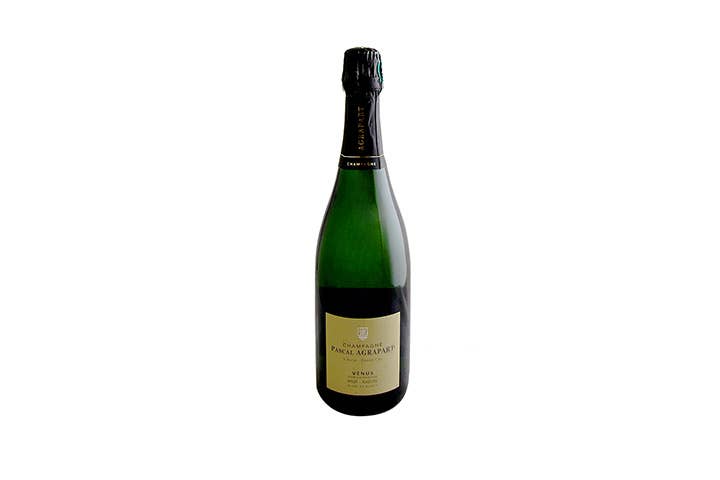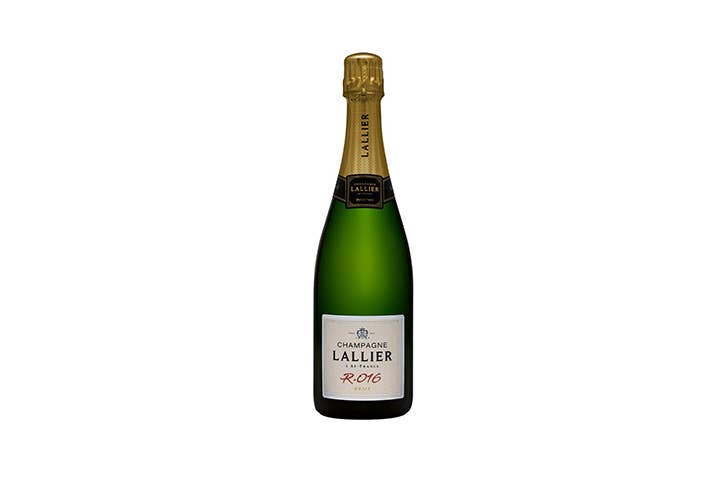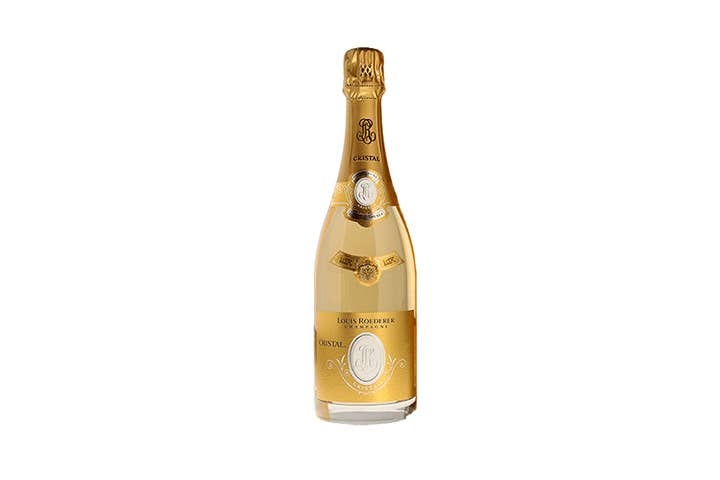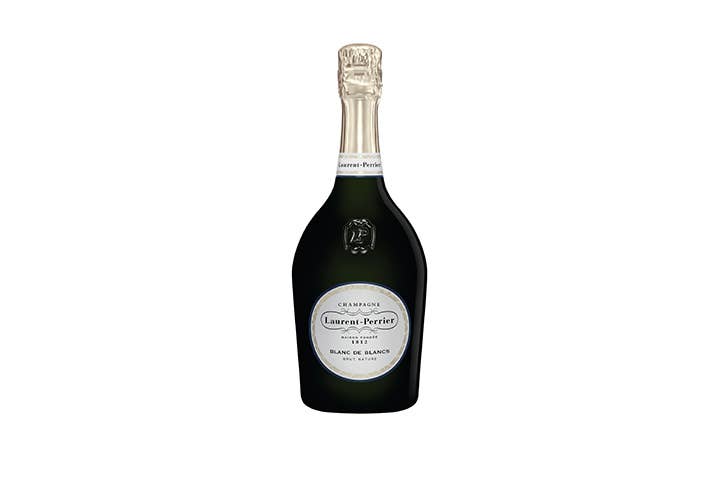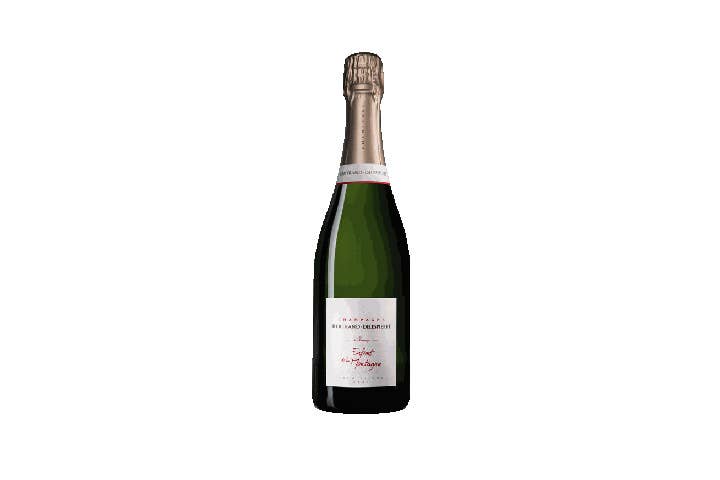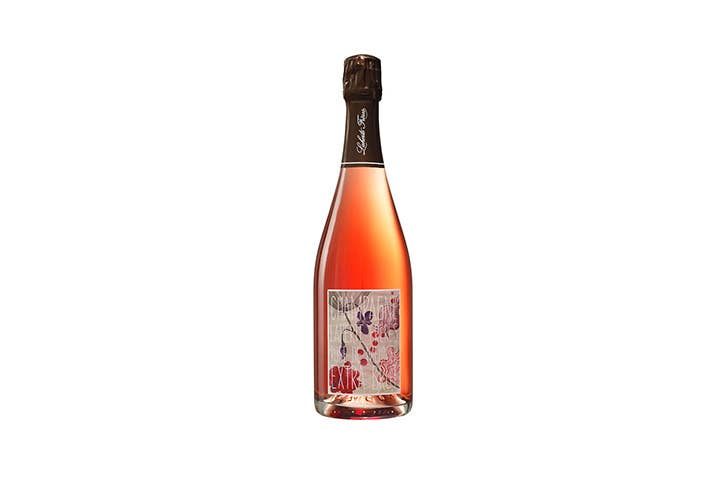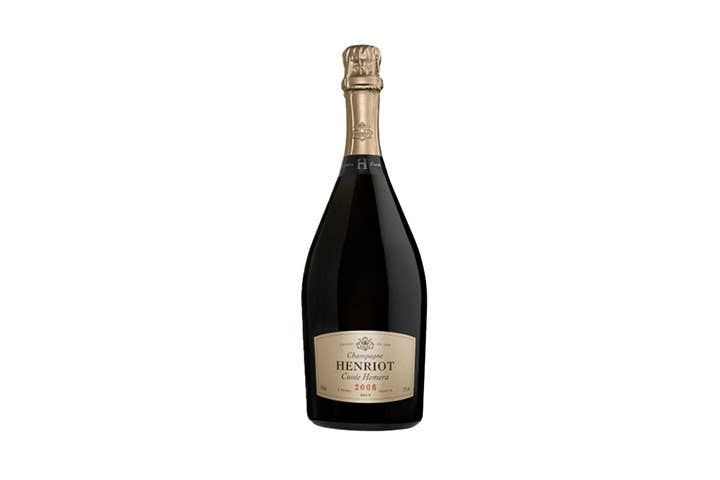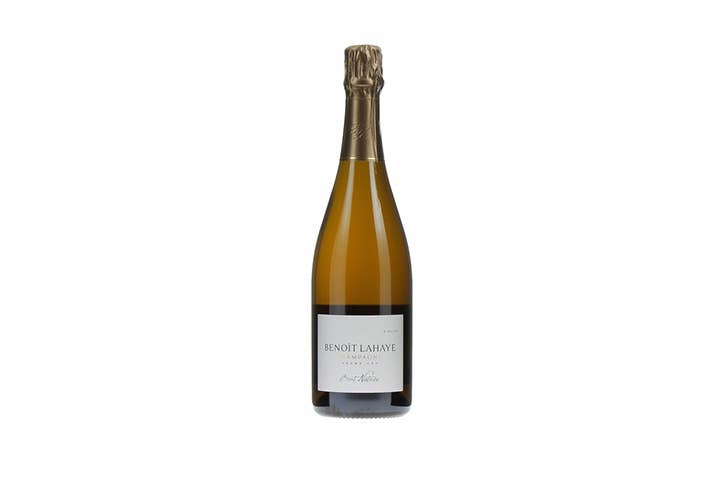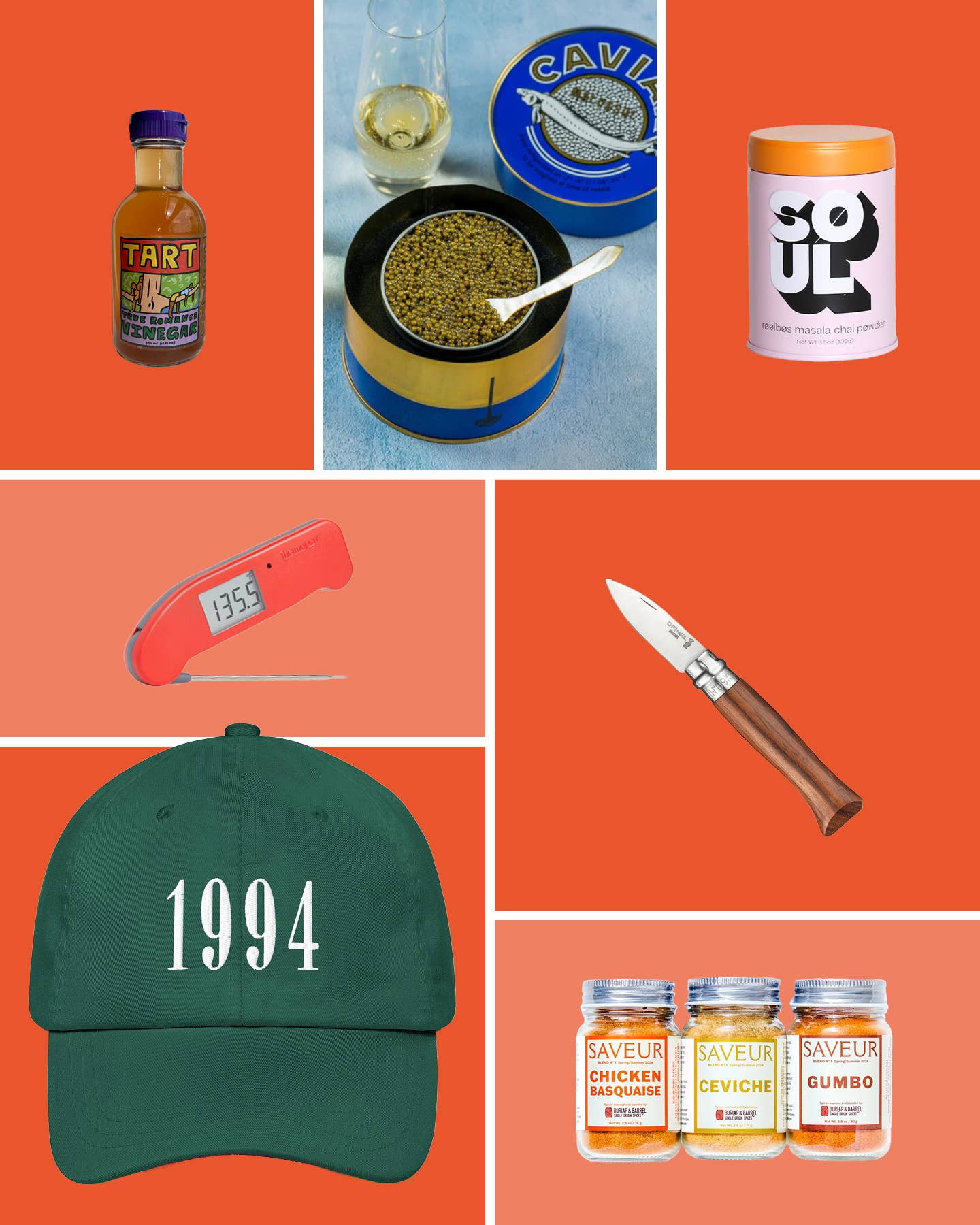You Don’t Need to Wait for a Celebration to Pop One of the Best Champagnes
Sommeliers, chefs, and winemakers share their picks.
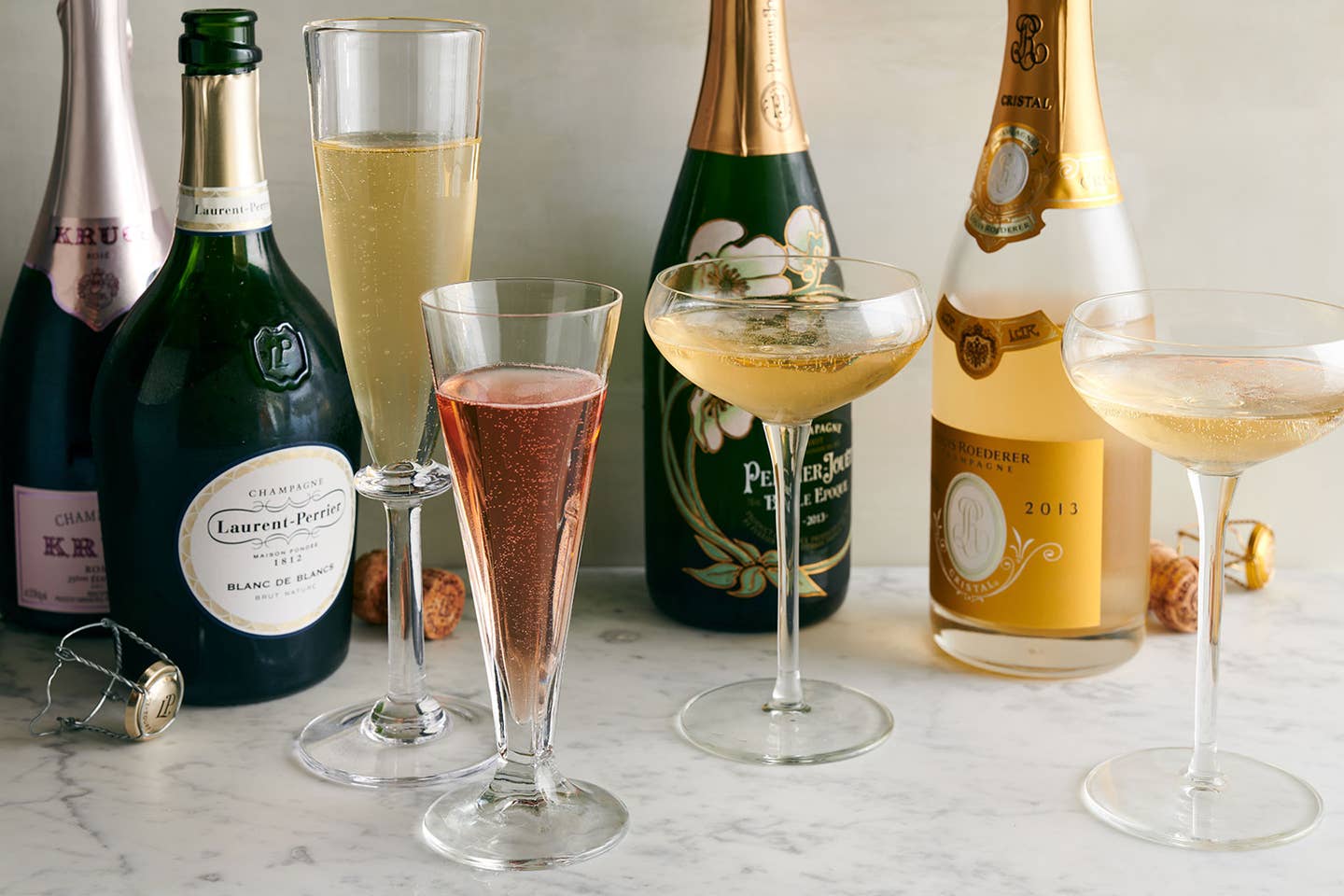
If you hand someone a glass of Champagne, odds are that they’ll instantly feel lighter, brighter, and a little more sparkling. There’s just something about bubbles that gently lifts you off your feet, whether enjoyed on its own or next to any number of dishes. The best Champagnes whisk you even further away, right into the heart of the French countryside, limestone soils and all—even if it’s a Tuesday night on the sofa. And while the heavy hitters like Veuve, Taittinger, and Dom will always pour consistently, it’s worth exploring beyond the grandes marques for your next bottle (but that doesn’t mean you shouldn’t still reach for the big houses every once and a while). So we tapped some of our favorite sommeliers, chefs, writers, shop owners, and winemakers to share their go-to Champagnes from all ends of the spectrum. Santé!
- Best If You Want Barrel Treatment: Vilmart & Cie Grand Cellier 1er Cru
- Best If You’re Looking For Vintage Grower: Larmandier-Bernier Terre De Vertus Premier Cru Blanc de Blanc
- Best For Bright, High Energy: Perrier Jouet Belle Époque Brut, Epernay 2013
- Best For Before and During Dinner: Franck Pascal 'Fluence' Brut Nature NV
- Best If You’re Really Into Pinot Meunier: La Closerie Les Béguines
- Best For Pairing With Hearty Dishes: Krug Rosé 25ème Edition NV
- Best For Leaning Into Chardonnay: Mousse Fils 'Anecdote' Lieu dit Les Varosses Blanc de Blancs Extra Brut
- Best To Experiment With Decanting: Georges Laval Cumieres 1er Cru Brut Nature NV
- Best For Fancy On a Budget: Jean Velut "Lumière et Craie" Blanc de Blancs Brut
- Best Save-For-It Grower: Agrapart Venus Blanc de Blanc Brut Nature 2015
- Best For During and After Dinner: Lallier Serie R.016
- Best Serious Splurge: Louis Roederer Cristal 2013
- Best For a Tower of Raw New England Seafood: Laurent-Perrier Blanc de Blanc Brut Nature
- Best Cool Crowd Pleaser: Bertrand-Delespierre Enfant de la Montagne NV
- Best Colder Weather Rose: Laherte Frères Rose de Meunier
- Best For Playing the Long Game: Champagne Henriot's Cuvée Hemera 2006
- Best Grand Cru Brut Nature: Benoît Lahaye’s Brut Nature Grand Cru
Our Top Picks
Best If You Want Barrel Treatment: Vilmart & Cie Grand Cellier 1er Cru
Best If You Want Barrel Treatment
Suggested Pairing: Rich salmon or tuna dishes, soft and creamy cheese | Grape(s): Chardonnay, Pinot Noir | Tasting Notes: Plums, cream, almonds, toast; a little citrus and spice
"I love Vilmart & Cie because it’s everything I want in a luxury Champagne, it’s rich and oaky thanks to the extensive barrel treatment, but it’s also produced by a fifth-generation family who maintains their own vines instead of a global conglomerate that would charge about twice the price for a comparable wine that wouldn’t be as good." —Tammie Teclemariam, writer and SAVEUR contributor
Best If You’re Looking For Vintage Grower: Larmandier-Bernier Terre De Vertus Premier Cru Blanc de Blanc 2013
Best If You’re Looking For Vintage Grower
Suggested Pairing: Oysters and crudo fish, or foie and quince jam on toast | Grape(s): Chardonnay | Tasting Notes: Peach pastry, almond skins, green and golden apples, Comté, and brioche
"Personally, I prefer to drink grower Champagnes (where the producer also raises the grapes), vineyard designate rather than a blend, and vintage rather than non-vintage. I find that these factors, along with winemaking processes that I also favor, make for a more characterful wine that conveys its own story with clarity. I love Larmandier-Bernier, and their Terre De Vertus Premier Cru blanc de blanc is absolutely lovely. The wine is 100 percent Chardonnay, and it shows off the minerality of the chalky soils. The release currently in the market here in Portland is the 2013, and this is because they keep the wine on the lees for 5 or more years (6 in the case of this vintage) before disgorging it. That extended lees contact creates layers of complexity and secondary flavors. This is a non-dosage Champagne, so no sugar is added back for secondary fermentation, and it is fermented with native yeasts and goes through spontaneous malolactic fermentation. The vineyard is biodynamic and the wine is not fined or filtered. It adheres to many of the tenets of natural winemaking, although they do use sulfur, and for this reason I feel a real kindred kinship with their winemaking philosophy. If I were to have the chance to make Champagne, this is exactly how I would make it." —Brianne Day, founding winemaker, Day Wines
Best For Bright, High Energy: Champagne Perrier Jouet Belle Époque Brut, Epernay 2013
Best for Bright, High Energy
Suggested Pairing: Salty cheeses or fish dishes dressed in butter | Grape(s): Chardonnay, Pinot Noir | Tasting Notes: Fresh peaches and pears, white flowers, buttery toast
"This has been my favorite for many years. In my early restaurant years, my first restaurant poured this Champagne by the glass out of a double magnum. It was in the Champagne swing which was popular in that era. This week, I had the opportunity to taste the latest vintage of Champagne Perrier Jouet, Belle Époque Brut, Epernay 2013. It was super fresh, bright, high energy, orchard fruits of pear, green apple, yellow apple, the acid and mineral are studded throughout the bursts of fruit. This will be my new luxury treat during the holiday season." —Tonya Pitts, sommelier
Best For Before and During Dinner: Franck Pascal 'Fluence' Brut Nature NV
Best for Before and During Dinner
Suggested Pairing: Beef carpaccio, Cipriani style | Grape(s): Pinot Meunier, Pinot Noir, Chardonnay | Tasting Notes: Stonefruit, citrus, viennoiserie
"One of my favourite Champagne producers is Franck Pascal, who has four hectares of biodynamic viticulture. His Champagnes show both elegance and power at the same time, very food friendly but definitely for special occasions. Try the 'Fluence', mainly Pinot Meunier, or the 'Reliance'." —Marco Lami, sommelier, Cibreo Group
Best If You’re Really Into Pinot Meunier: La Closerie Les Béguines
Best If You’re Really Into Pinot Muenier
Suggested Pairing: Shellfish | Grape(s): Pinot Meunier | Tasting Notes: Bready, fruit-forward
"My introduction to La Closerie auspiciously took place some years ago, at a restaurant in Burgundy while visiting France with friends who are, it's probably OK to say, obsessed with wine. My contribution to the research trip—we had briefly pivoted from our Rhône focus—was less about makers and vintages, and more about my French speaking skills and the longstanding enthusiasm we share for delicious, evocative wines. Also I have a discerning palate, if I say so myself, and my friends were like, yes you can come on our Very Serious Wine Expedition.
That fateful déjeuner featured 4 bottles, and La Closerie was one of them. I hadn't tasted a pinot meunier Champagne before and was immediately intrigued by its fullness. As a saison fan in the beer department, I connected with its bready but fruit-forward notes. It was clean but not astringent, and lacked the lemony, zesty vibe that I sometimes felt taxed by with blanc de blancs. Later I learned more about the single vintage philosophy of Prévost's process and the 'renegade' approach he and other makers take to evoke the truest nature of the harvest, instead of forcing a standardized blend year after year. From that point on, I was a convert.
Since then, Les Béguines and the outstanding rosé from that house, Fac-simile, have become widespread, highly sought-after favorites, likely not surprising to many readers. It's probably harder than ever to get one's hands on a bottle, and this blurb isn't going to do me any favors in the allocation race! But that tasting experience shifted my expectations of what Champagne could be and I'd be wrong to say otherwise." —Osayi Endolyn, writer
Best For Pairing With Heartier Dishes: Krug Rosé 25ème Édition NV
Best for Pairing with Heartier Dishes
Suggested Pairing: Roasts and well-seasoned preparations | Grape(s): Pinot Noir, Chardonnay, Pinot Meunier | Tasting Notes: Honey, citrus, dried fruit
"Krug Rosé 25ème Édition is a blend of majority pinot noir from eight years dating back to 2008 with a base wine of 2013. In the tradition of Krug, this wine has tremendous depth, complexity, and finesse, and is a perfect pairing for elegant dishes. I love this wine for its deep flavors to harmonize with my more soulful dishes. It can happily stand side by side with roasts and well-seasoned preparations." —Daniel Boulud, Chef and Restaurateur
Best For Leaning Into Chardonnay: Champagne Mousse Fils 'Anecdote' Lieu dit Les Varosses Blanc de Blancs Extra Brut
Best For Leaning Into Chardonnay
Suggested Pairing: Lay's potato chips, among others | Grape(s): Chardonnay | Tasting Notes: Lemon confit, orchard fruit, floral notes
"My recommendation is Champagne Mousse Fils 'Anecdote' Lieu dit Les Varosses Blanc de Blancs Extra Brut. Cedric Mousse is one of my top Champagne producers and this is his first all-chardonnay Champagne. It's round with great acidity and can pair with tons of foods, but my favorite is plain Lay's. A great combination." —Julia Coney, sommelier
Best To Experiment With Decanting: Georges Laval Cumieres 1er Cru Brut Nature NV
Best To Experiment with Decanting
Suggested Pairing: Green salads, sushi, and seafood | Grape(s): Chardonnay, Pinot Meunier, Pinot Noir | Tasting Notes: Green apple, white tea, salinity
"It is always hard for me to choose a favorite Champagne, but one wine that my eyes always gravitate towards would be the wines of Vincent Laval. This tiny estate located in the western edge of Montagne de Reims never ceases to impress me. His Cumières 1er Cru, for me, checks all the boxes. Taut, richly textured, savory but with a hint of fruit. These wines are sure to keep you shouting tasting notes once you get past the slight austerity. Dare I say, decant it?" —Blake Bernal, sommelier at Le Pavillon
Best For Fancy on a Budget: Jean Velut "Lumière et Craie" Blanc de Blancs Brut
Best For Fancy on a Budget
Suggested Pairing: Bagels and lox or salmon roe | Grape(s): Chardonnay | Tasting Notes: Lemon curd, pear, minerality, white flowers
"When one of my oldest friends, a buyer at a fancy wine shop in Manhattan, invited me over for dinner a few weeks back, he handed me a glass of “mystery Champagne." Right off the bat, I could tell it was expensive. The wine possessed all the depth of flavor and chalky mineral tension that I tend to associate with the kinds of bottles I can’t personally afford.
Well, it turns out I was wrong. Hailing from Champagne’s southernmost sub-zone of the Aube—a historically lesser-known part of the region that has lately emerged as a hotbed of experimentation—the Jean Velut “Lumière et Craie” Blanc de Blancs Brut would still be a bargain at $100. Remarkably, a standard 750ml bottle costs not even half that amount. Unlike most Champagnes at this approachable price point, the wine is assembled entirely from a solera system of older “reserve wines,” which imparts that extra dimension of richness and savory complexity. It's yet another testament to the rewards of steering clear of the usual big brand names and exploring Champagne's rising tide of small, independent growers." —Zach Sussman, writer
Best Save-For-It Grower: Agrapart Venus Blanc de Blanc Brut Nature 2015
Best Save-For-It Grower
Suggested Pairing: Oysters and ceviche | Grape(s): Chardonnay | Tasting Notes: orchard fruit, grapefruit rind, roasty nutty pastry, baking spices
"I was fortunate to taste the first vintage of Agrapart Venus at the winery and was blown away! It’s a wine that will always stay with me (and keep me saving up to purchase it). The most exciting things happening in wine today have been happening in Champagne. And thanks to a great set of importers seeking out these new offerings, we in America have been blessed with access to a variety and availability of French Champagnes that are lighting up dinner tables nationwide. The growth and the change of the Champagne community over the last two to three decades is coming from the next generation of vignerons who have extracted their family lands from some of the grandes marques and have put an edgier stamp on the style of their offerings that is downright thrilling. The low dosage (low sugar) and low pressure (less CO2 in bottles) in some bottlings are making Champagnes more vinous and excellent for food pairing." —Dan Petroski, winemaker, Massican
Best For During and After Dinner: Lallier Série R.016
Best For During and After Dinner
Suggested Pairing: Paris-Brest, roast chicken, cheese and figs | Grape(s): Chardonnay, Pinot Noir | Tasting Notes: Citrus blossom, blanched almonds and hazelnuts, caramel, subtle baking spices
"2016 was not an incredibly kind year to Champagne vignerons. There was a cool, humid first six months of the year; heavy rainfalls; late spring frost; scorching summer weather. Ripening was delayed, but by September things had gotten on—even though yields were very small comparatively. Honestly, in bottle, drinkers are lucky to experience the freshness and tension present in this vintage. The vintage is beguiling, all slippery silk with lively bubbles to break things up. The base wine year is displayed on each bottle Lallier’s Série R line. I sipped this alongside a homemade Paris-Brest made with black tahini pastry cream and I loved how the nuttiness in each complemented the other." —Samantha Weiss Hills, deputy commerce editor, SAVEUR
Best Serious Splurge: Louis Roederer Cristal 2013
Best Serious Splurge
Suggested Pairing: Enjoy it in its singularity | Grape(s): Pinot Noir, Chardonnay | Tasting Notes: Fresh, juicy, savory; plums, nectarines, citrus zest, nuts
"Cristal 2013 is pale gold and has tiny beads, plus an intense nose of fresh almonds, lemon zest, and blossom. It’s tight and tense with masses of acidity and freshness, but not painfully so. Neat and a little introverted, but is clearly made up of many layers and is extremely persistent. A fine mix of intellectual and pleasurable—gorgeous, zesty, and real essence of Cristal. Thirty-two percent of the wine was aged in oak, and no malo fermentation. Dosage was 8 g/l." —Jancis Robinson, wine writer and critic
Best For a Tower of Raw New England Seafood: Laurent-Perrier Blanc de Blanc Brut Nature
Best For a Tower of Raw New England Seafood
Suggested Pairing: Raw shellfish | Grape(s): Chardonnay | Tasting Notes: Mineral, citrus (lemon and clementine), florals, salinity
"For festive occasions, my go-to bubbly is usually Laurent-Perrier's Brut La Cuvée. It's bone-dry but still really hits that balance between bright, lush fruit and toasty brioche that I love so much in a champagne—I am a former pastry chef, after all! This year, though, I've been feeling the need for a little more levity, so I'm swapping out my usual bottle for its flintier, more citrusy sister. The house's Blanc de Blanc Brut Nature has a bit more minerality to it than the Cuvée, along with a ton of pretty florals, lemon, and clementine on the nose and a crisp, faintly saline finish. I'll be pairing it with plenty of raw New England shellfish." —Kat Craddock, editorial director, SAVEUR
Best Cool Crowd Pleaser: Bertrand-Delespierre Enfant de la Montagne NV
Best Cool Crowd Pleaser
Suggested Pairing: As an aperitif, or with pad Thai | Grape(s): Pinot Noir, Chardonnay, Pinot Meunier | Tasting Notes: Orchard fruits, lemon peel, light spiced oats, gentle florals
"We have been pouring this wine for a while, but it quickly became my (and everyone here at Graft's) go-to bottle. I was unfamiliar with it before we started doing it by the glass, but the bang-for-your-buckness of this wine is insane. It's really hard to find well-made, grower Champagne under $50, and not only does this wine accomplish that, but it also out-drinks a lot of bottles that are $30 to $40 more expensive. Did I mention that the fruit is entirely 1er Cru? This is a no-brainer this holiday season—it's lean enough to satisfy the more esoteric Champagne drinkers, but has a richness that is familiar with the more traditional style." —Miles White and Femi Oyediran, Owners, Graft Wine Shop
Best Colder Weather Rose: Laherte Frères Rose de Meunier
Best Colder Weather Rose
Suggested Pairing: Schnitzel, ragu | Grape(s): Pinot Meunier | Tasting Notes: Bright cranberry, black pepper, citrus, strawberry, rose petals
"Ever since the first day I had the entry level brut Laherte, I was pretty much sold. Laherte Champagne is exactly what I want in a Champagne: Crisp, clean, tiny fine bubbles; bright citrus; and not to mention price to quality is unmatched. I’ll particularly choose the rose because of the lush bright tangy fruit, gentle bubbles, and the finesse is just flawless. This one goes so well with food, which in the colder months we all tend to eat a bit heavier and hearty." —Marquis Williams, Founder, Highly Recommended
Best For Playing The Long Game: Champagne Henriot's Cuvée Hemera 2006
Best For Playing The Long Game
Suggested Pairing: lobster, poultry | Grape(s): Chardonnay, Pinot Noir | Tasting Notes: Soft peach, salinity, baking spices, croissants
"In general, I look for Champagnes that have character and personality—there's nothing better than taking a sip of wine with a particular flavor or quality (or combination thereof) that you've never experienced before. When I encounter a Champagne like this, I never forget it. And while this is all highly subjective, I can safely say that Champagne Henriot's Cuvée Hemera 2006 is a wine so uniquely elegant that it's bound to leave an impression on just about anyone—an equal parts blend of Pinot Noir and Chardonnay grapes from the family-owned house's six founding crus, Cuvée Hemera is aged for a minimum of 12 years before its release and is incredibly complex on the palate with notes of soft peach, slightly bracing saline, baking spices, and buttery croissant leading into a ridiculously long finish." —Céline Bossart, wine and spirits writer
Best Grand Cru Brut Nature: Benoît Lahaye’s Brut Nature Grand Cru
Best Grand Cru Brut Nature
Suggested Pairing: Roasts and braises | Grape(s): Pinot Noir, Chardonnay | Tasting Notes: Rich, nutty, ripe apples, minerality
"I have two go-to bottles these days—both from staunch farmers who tend their vines biodynamically, and both from the region’s black grapes. The first is Benoît Lahaye’s Brut Nature Grand Cru. Lahaye is based in the Montagne de Reims and is a Pinot specialist, and was just named “vigneron de l’année” (winegrower of the year) by Gault & Millau. This cuvée leans into the red fruit character of Pinot Noir, so it can stand up to more robust dishes like roasts and braises and doesn’t need to get the “aperitif-only” treatment. The second is Christophe Mignon’s ADN de Meunier Brut Nature, which is a true Blanc de Noirs made from 100 percent Pinot Meunier. Like the Lahaye, this could easily handle a main course, but I drank a bottle for Mother’s Day this year with Mere Point oysters, and it was such a pitch-perfect pairing that I just want to recreate the moment over and over." —Carson Demmond, sommelier and founder of Rive Gauche Wine
How We Chose These Products
When it comes to Champagne, to each their own (much like wine tasting in general). That’s why we asked experts working in the field—sommeliers, chefs, writers, shop owners, and winemakers—to share their go-to Champagnes of the moment. (Plus, there’s a few of our own favorites on the list.) We looked for a mix of price points; big houses and grower; blends and single varieties; nonvintage and vintage; and geographic diversity across the region.
Features to Keep in Mind
Region and History
Champagne is, in effect, one of the coldest wine regions in the world (but due to climate change, this fact is fast shifting), and home to prized, rich limestone soils, some of which are known as chalk. Made up of five subregions—Montagne de Reims, Vallée de la Marne, Côte des Blancs, Côte de Sézanne, and The Aube—it spans about 85,000 acres, with the towns of Reims and Épernay the nexus of production for centuries. It’s historically a precarious place to grow vines and ripen grapes—an average temperature of 50 degrees Fahrenheit and very cold winters, plus late summer rain threatening rot and mildew, vary the crop each year—but this weather pattern, in partnership with its soils, produces the grapes that Champagne is known for.
This region in northeast France has been home to the famous sparkling wine since the latter half of the 17th century—that’s when Dom Pérignon (yes, that Dom) led the charge toward improved winemaking in the area. And, as Robinson states in The Oxford Companion to Wine, the business of Champagne began in earnest in the early 19th century, thanks to one Madame Clicquot (yes, that Clicquot), with the invention of pupitres, racks that help with riddling, or twisting bottles to move sediment into the neck before disgorgement. It was also around this time that the Champenois, or Champagne merchants, savvily began self-promoting their product, solidifying its status as a luxury item, an opinion that persists today. Further developments and understanding of second fermentation in the late 19th century paved the way for the Champagne Appellation d’Origine Contrôlée (AOC) in 1927 (ahem, but not before phylloxera’s stranglehold and a world war, or fraud scandals and some riots greatly impacting Champagne’s vineyards). However, these setbacks didn’t inhibit thirst for the wine; hundreds of millions of bottles sold every year for decades in the 20th and early 21st century. But over the last few decades, after lengthy market dominance by the grandes marques, small producers and growers have stepped into the limelight in the region, highlighting its varied terroir in a way that the big houses don’t, or can’t.
Grapes
The three main grape varieties you’ll encounter in a bottle of Champagne will be chardonnay, pinot noir, and pinot meunier. The blend of these grapes—or focusing on one variety—can, just like with other sparkling or still wine, produce wildly different stylistic qualities.
- Blanc de Blancs: 100% Chardonnay
- Blanc de Noirs: 100% Pinot Noir
- Nonvintage: Produced with grapes from multiple harvests
- Prestige cuvée: Considered the best of the best blends
- Single vineyard: A Champagne produced from one vineyard instead of blending grapes from several plots
- Vintage: Must be aged for a minimum of three years
Cru Ranking
There are 320 crus in the one appellation of Champagne, ranked descending as either Grand Cru, Premier Cru, or Cru in the Echelle des Crus system. A cru ranking is based on what villages the vineyards are located in, their status and location.
Process
Champagne is made in the traditional method (or méthode traditionelle) which includes the following steps: Picking and pressing grapes; primary fermentation for a still base wine; secondary fermentation thanks to the addition of liqueur de tirage (sugar and yeast); aging in the bottle sur lie (on the lees, or spent yeast cells), during which autolysis takes place and lends the wine richness and texture; remuage, or riddling; and then disgorgement and recorking, readying the bottle to be sent out and sold.
Dosage
When a bottle of Champagne is disgorged—the process in which sediment is removed from the bottle—and before it is recorked for market, winemakers have the opportunity to add dosage. This sugar-base wine mixture traditionally balances Champagne’s bracing acidity, and there are several tiers of added sugar/dryness. The majority of Champagnes you’ll find on the market today fall in the first three to four categories; sec, demi sec, and doux have less of a presence.
- Brut Nature: Zero or less than 3 grams of sugar
- Extra Brut: Zero to 6 grams of sugar
- Brut: Less than 12 grams of sugar
- Extra-Dry: 12 to 17 grams of sugar
- Sec: 17 to 32 grams of sugar
- Demi Sec: 32 to 50 grams of sugar
- Doux: 50 grams or more of sugar
Pairing
Pairing dictums don’t mean much, in general—yes, there are some guidelines to follow, but don’t pay hard and fast “rules” any mind—and Champagne shouldn’t be relegated to aperitifs. It’s one of those styles that really joins well with, and is enhanced by, a number of dishes, from sushi and pad Thai to steak or fried chicken. Its acidity cuts through fat like a well-honed knife, and its fizz complements textures in food. Sparkling wines are a good fall-back option when you’re not sure what to order; when in doubt, go with bubbles, says wine writer Jon Bonné in his book The New Wine Rules.
Ask the Experts
Q: What is the difference between Champagne, cava, and prosecco?
The most significant difference between Champagne, cava, and prosecco is that all three wines come from completely different parts of the world and feature completely different grapes, says Zachary Sussman, wine writer and author of Sparkling Wine for Modern Times. “A sparkling wine can only be called Champagne if it comes from the Champagne Region of France, the country's northernmost growing area,” he explains. “In the chilly vineyards outside the city of Reims, the pinot noir, pinot meunier and chardonnay grapes find ideal conditions for the production of racy, high-acid sparkling wines.”
Cava, by contrast, hails from the sunny Mediterranean—historically, the Catalonian area of Penedès not far from Barcelona, where the mix of local grapes include (for whites) Macabeo, Xarel-lo, and Parellada and (for reds) garnacha, trepat, and monastrell. As a result, Sussman points out, you'll find that cava typically has richer, riper, fleshier flavors than Champagne. Finally, Prosecco's ancestral home lies in Italy's Veneto region, where the delicate, floral Glera grape has grown for centuries.
“Beyond these geographical differences, though, there are also differences in production method,” advises Sussman. “Both Champagne and cava are produced using the "traditional method" of fermentation—also called the "méthode champenoise," or metodo classico—whereby the secondary fermentation takes place within each individual bottle.” This is widely considered the most time-consuming and labor-intensive way to produce sparkling wine, but Sussman says that it also gives the most refined results, with a firmer, more persistent effervescence and fuller, more savory flavors. Stylistically, he points out, traditional method wines represent a stark contrast to those produced in the Charmat, or "tank method," how Prosecco is made. Secondary fermentation takes place on a much larger scale in giant stainless steel tanks. While the results tend to lack the complexity of Champagne, Sussman says, the Charmat method goes a long way towards preserving a wine's fresh fruit flavors and aromas. “In this way, Prosecco's light, easy-drinking appeal—and iconic status as a "brunch wine"— is a direct reflection of the specific production method that brings it into being,” he adds.
Q: How do I pour Champagne?
The best way to pour Champagne, sommelier Julia Coney advises, is to first remember to turn the bottle, not the cork—and to never remove your hand from the cork. “Loosen the cage by turning six times to the left with your dominant hand, maintaining the non-dominant hand holding the cork and the cage,” she explains. “With your dominant hand, slowly begin to turn the bottle as you feel the cork begin to loosen. You want to hear a slight hiss from the cage releasing from the bottle and not a pop."
Coney says to tilt your wine glass diagonally and slowly pour—the glass should never be full. “You always want to be able to smell the aromas and swirl the Champagne,” she goes on. “Remember, Champagne is wine. A white wine glass is best for drinking Champagne as you explore all its nuances.”
Q: What type of glasses do I need for Champagne?
Wine and spirits writer Céline Bossart says that the ideal glass for Champagne is up for debate amongst sommeliers and other wine pros around the world. As Coney pointed out, many will say that a high-quality, all-purpose white wine glass is their top choice. Others swear by a more Champagne-specific style, namely a tulip shape, as coupes and traditional flutes are generally not the best in terms of aroma delivery.
“I also once spoke about this with the legendary Godefroy Baijot of Besserat de Bellefon, and he actually prefers to use a tiny stemless Moroccan tea glass, or ‘blida,’ as its smaller size means more frequent topping-off, so your wine is consistently fresh and ultra-effervescent,” she remembers. It also, she adds, makes the Champagne drinking experience feel slightly less stuffy and more convivial, which is never a bad thing. “It's an inherently fun, happy wine and should be more approachable, in my opinion,” she says. “To me, there's nothing better than pouring myself a glass of bubbles on a Tuesday afternoon for absolutely no reason.”
Q: How long can Champagne last after a bottle is opened?
“Let me preface this by saying that I rarely find myself with leftover sparkling wine,” Sussman says with a laugh. “The stuff tends to disappear quickly in my household. That said, in my experience, this really depends upon how much is left in the bottle.” The higher the fill, he explains, the longer the bottle will last once opened.
Thanks to their stronger bubbles, traditional-method wines like Champagne will take longer to lose their fizz than Prosecco, but Sussman wouldn't recommend keeping either open in the fridge for more than 24 hours. He adds that it helps to invest in a specific gadget known as a Champagne stopper (such as this one, which he uses at home; there are dozens of different brands, but they’re all basically the same), designed to prevent an open bottle of bubbles from going flat. “The process is incredibly simple,” he says. “You just clamp it down on the rim of the bottle and it creates a perfect seal, maintaining the pressure of the bubbles overnight (and often even after a few days).”
Our Take
While there’s no need to turn your nose up at them, break free of the expected bottles when popping open your own bubbles. Seek out grower Champagnes, rosé, barrel treatment, and even 100 percent Pinot Meunier—and pour a round for friends, any day of the week.
Keep Reading
Continue to Next Story
